Lecture 11
Video
Reliability Availability Servicability (RAS)
- any device working ar notmal operation, ails, then gets repaired then normal operation starts
- this is Operate-repair cycle

- mttf = reliability
- mttr = servicability
- time to recover node, to make it work again
- availability = (time it worked)/(total time)
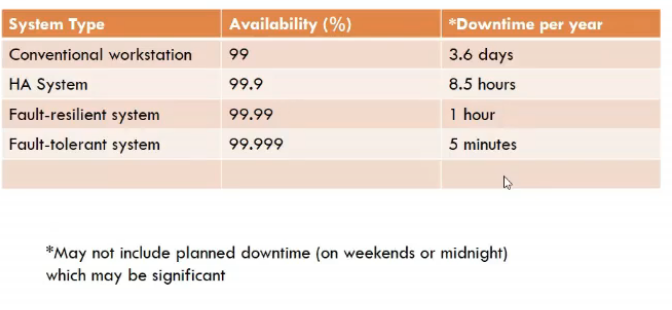
- 9s ke term me
- 2 9s, 3 9s, 4 9s, etc..
Failures
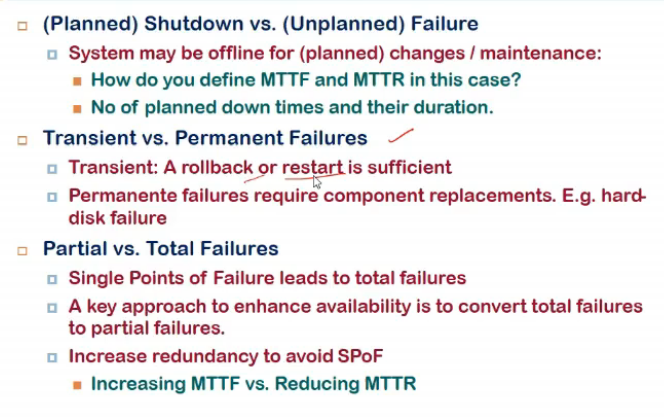
- in both shutdown, and unplanned, system might be offline
-
planned one r not included in recover, only in failure
- transient = just restarting a service, rollback is sufficient
-
permanent = during the failure, I cannot use system, some imp component has failed
- partial failurres preferred over total
- total happens when Single point of failure hai
- so our goal is to remove SPOF
- to increase availability
- increase MTTF
- or, decrease MTTR
- easier than above
- MTTF predefined aata device ke saath
- MTTR? SPOF me recovery takes time (maintenance wale ko bulao woh check karega, fault bataya etc etc)
- instead if we have 2 systems running parallely, one fails, other chala le, MTTR = 0
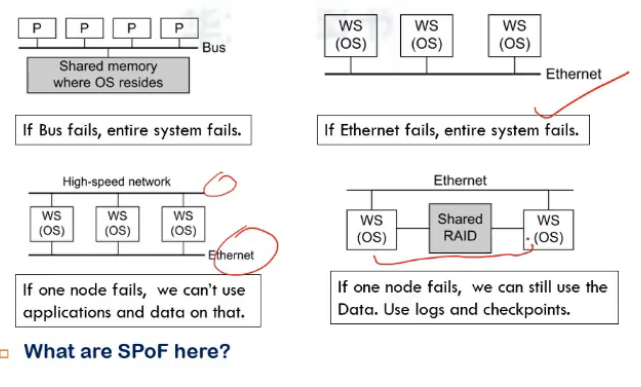
- furst me Shared memory or Bus both are SPOF here
-
shmem in gen bmultiple h/w units ki bani hoti, so bus hi main imp hai
- workstations connected to ethernet
-
SPOf = ethernet
- third me
- we have 2 networks in parallel
- assuming each workstation is provided diff service, then if one node is down, we cannot use applications and data present on it
- fourth me
- shared RAID
- shared file system = disk structure hai
- each ndoe can access other’s
- so agar ek node bhi fails, I can use second, data can be accessed using logs and checkpoints etc
- shared RAID
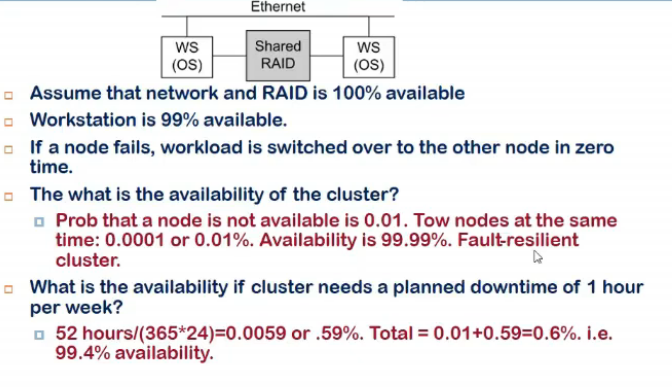
- workstatipon is available 99% of timr
- but if one fails, other is accessible
-
how to get availability of whole cluster
- serial me agar hai 2 devices both having avail = 0.99, then total avail = 0.99*0.99 (bcz even if one fails, whole system fails)
- if in parallel
- failure happens only when both fails
- so (1-0.99)*(1-0.99)
- this is failure prob, so avail = 1-0.0001 = 0.9999

-
so serial me total avail goes down, agar parallel me kia (backup hai, stand by pe), avail increases
-
last ques me
- 52 weeks so 52 hours not available in a year out of (365*24) hours, also 0.0001 percent times bhi nahi available
Failover
- reducing MTTR
- move services which are down to another system
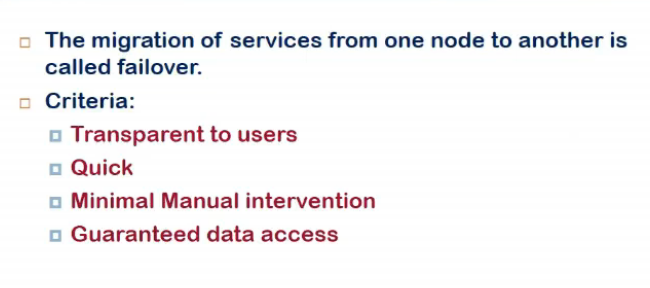
- whatever changes done in prev node, should be visiblle in destination node
- some connections might break (TCP conenction tha, IP changed abhi..)
- so we might have DNS based solution
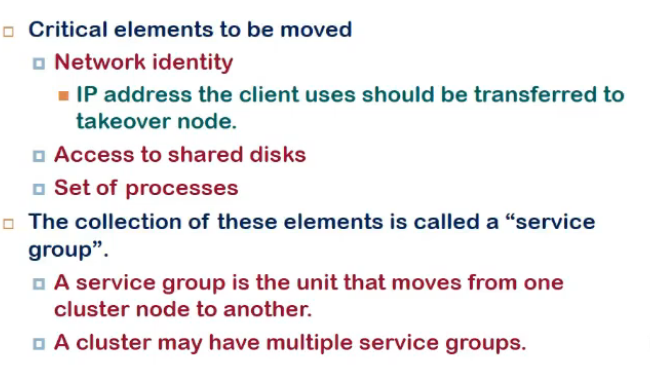
- load balancer can still redirect request to new server
- access to shared disk is imp, bcz agar sab apna local store karegam tehn fail hote hi bt (RAID, SAN vagairah me)
- set of processes
- process migration is tough to acheive
- bcz bahut kuch os space me horta related to a process
- one way is checkpointing
- store all related details into a file an dfile ko dusri jagah le ja
- second way is make it stateless
- process does not remember it
- request state vagairah maintain karega
- VM me yeh easy to implement
- bcz os se independent hote woh
- sErvice group
- anyth related to a particular service jisko migrate karna
Failover Requirements
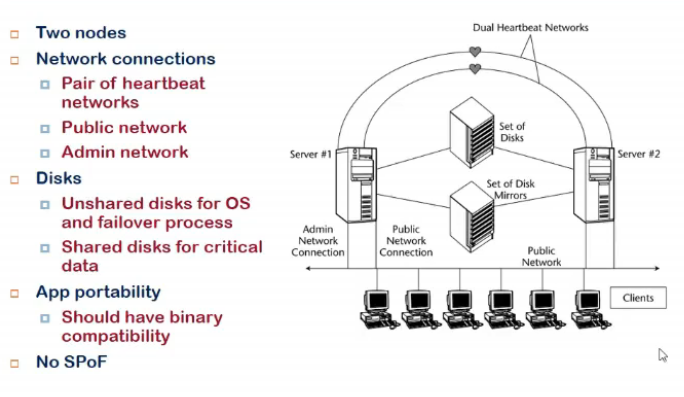
- fual n/w conenctivity chahiye, ek fail hua toh dusre me daalde
- set of disks shared by both, and some local related disks
- portability
- a service running on server 1, move karna 2 pe, diff library version/new os version etc nahi hona chahiye bt, compatibility honi chahiye executable program ki
- this makes it no sPOF
Two-Node Failover configurations
- possible cluster configurations
- active passive(hot standby(already ready))
- primary and standbyy(active and passive)
- only prim accept requests
- secondary ka data shared with primary
- second monitor primary node, if fails it becomes main node
- passive ke failure ke chance kam since kuch kar nahi raha
- but mehnga tabhi
- so only critical applns jinko biulkul downtime nahi dena, unko is mode me run kar
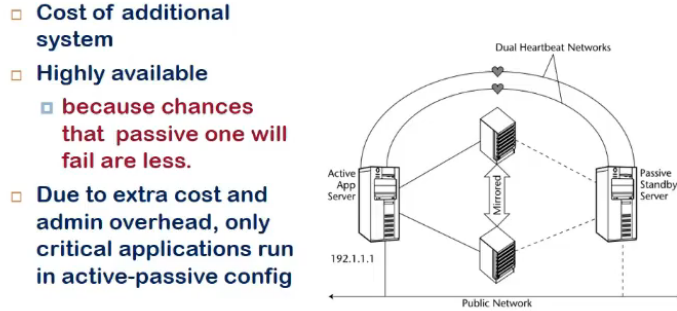
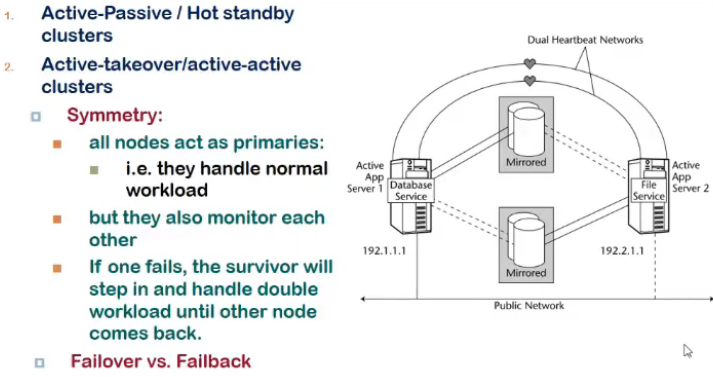
- active active
- both are receivinf requests
- they both monitor each other
- if one fails, other will handle load coming to second

- concept of failback
- failover me migration tha
- active-active me when it recovers, applns fail back to original node, since both are active active
- active-acti me manageable cost
- but performance impact when single node handle much load
- and uske fail ke chance increase when one fails
Now, Large cluster configurations
- 2 se jyada
- ab kaise configure kare
- 2 type se
- N-to-1
- N + 1
N to 1
- a designate dnode acting as standby
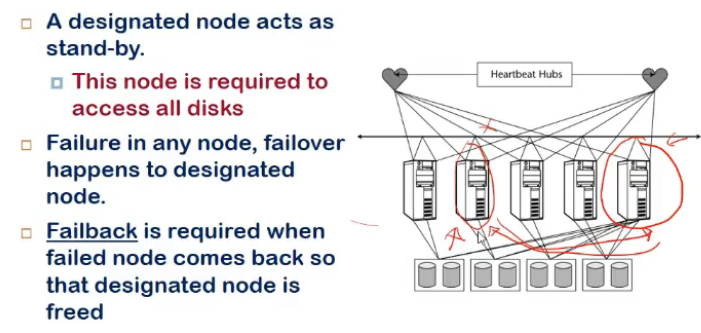
- designated node access all shared data (written by other system)
- if failure hua, failover happens to designated node
- failback is reqd when faile done comes up
N plus 1
- all node have state storage (SAN use karre maanle)

- failback/failover me applns are not available
- yaha pe no failback, so availability increases
- designated node is dynamic
-
jab failed node is repaired, it becomes a designated node
- VMs me easy failover vagariah
- waha pe abstraction alag
- yaha pe it is in terms of processes
Problem
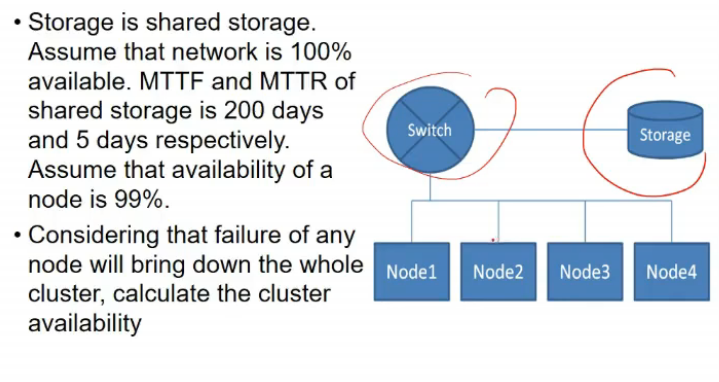
- all nodes are in series, switch failure bhi system fail, storage also
- n/w is 100% avail, MTTf, MTTr of storage given, so avail of storage givem
- so ans is 1*(200/200+5)*(0.99*0.99*0.99*0.99)

- now parallel thing hai
- when it will fail?
- switch fail
- storage fails
- all the nodes fail
- so, 1*(200/205)*(1-(1-0.99)^4)